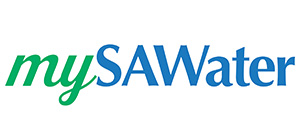Welcome to SA Water
Welcome to SA Water
Whether you’re an existing customer or receiving our services for the first time, we want to say welcome.
Every day we support the liveability and wellbeing of our community by ensuring the reliable delivery of safe, clean drinking water, and the removal and treatment of wastewater for homes and businesses right across South Australia. In delivering your water services, we also care for the environment and are building climate change resilience through our goals to achieve zero net emissions and zero net waste.
Sign up for eBilling
To receive your bills via email, please register for mySAWater, our online bill management tool. In mySAWater, you can also:
- pay bills online or set up direct debit
- manage multiple properties
- view your transaction history
- understand your water use
- update your billing address and contact details.
By providing your phone number, you'll receive a text message if your property is impacted by a temporary service interruption.

Registering for mySAWater
Residential customers can use mySAWater to view, pay and manage their account 24/7, as well as access other helpful tools.
How to read your bills
Your bill includes important information about water use, payment status and costs for the services we provide.
![]()
Paying your bill
Pay your water bill in the way that suits you best. You may be eligible for a concession, and we may be able to help if you’re experiencing financial difficulties.
What to do if something goes wrong
Blockages, leaks and temporary service interruptions can be challenging. Find out how to search for known faults in your area and report new problems.
![]()
Water saving tips
Saving water is great for the environment, and it can help reduce your water bill. Discover tips for saving water in your home and in your garden.
![]()
Connect with us
You can connect with us on our social channels, by emailing us, calling the Customer Care Centre or by sending us a message online.
Commonly asked questions about the bill
Why does my first bill have usage on it from before I moved in?
Our accounts are property based, not customer based. This means that when a property is purchased the account transfers from one owner to another. As part of the settlement process the vendor's conveyancer will calculate how much water the vendor has used and contribute that amount to the first bill. So while you will have some water usage on the bill from prior to your ownership, this should have all been paid for during settlement. If you do not believe it has been paid for, we advise you contact your conveyancer.
Why does my account have a previous balance when this is my first bill?
Our accounts are property based, not customer based. This means that when a property is purchased the account transfers from one owner to another. On your first bill the previous balance and amount paid are related to the previous owner of the property. A payment has been made by the vendors conveyancer up until your move in date. This payment amount was calculated by the conveyancer after we read your meter.
Why am I getting a bill when I’m not connected to the water or sewer mains?
All properties situated along a water or sewer main are subject to rates even if they are not connected. This is outlined in the Water Industry Act 2012. The provision of public utilities, such as water and sewer mains, are of benefit either directly or indirectly to the community. It is therefore considered reasonable that all beneficiaries who do, or can, benefit from obtaining connections should contribute to the ongoing cost of providing these important facilities.
Water pricing for residential properties includes an annual charge for the service and a tiered pricing system for water use. Residential properties include houses, maisonettes, home units, flats, strata and community title residences.
Sewerage rates are payable on any land situated along a sewer main that is available for connection regardless of whether or not the property is connected to the sewerage system.
The basis for sewer rating is the capital value of the property at 1 July each year determined by the Valuer-General. Should you wish to query the capital valuation of your property, you need to contact the Valuer-General.
Why does my bill say 'estimated bill' and what does it mean?
To prepare your bill, our team needs to enter your property to read the meter. If the meter is obstructed, or we can’t safely and conveniently access and read the meter, we may estimate your usage based on your history. If we don't have a history of your usage at that supply address, we use the average usage by a comparable customer over the same period. We'll let you know if your bill is based on an estimated reading of the meter by noting it clearly on your bill.
If you have been issued with an estimated bill, and we can access and read the meter in the next billing period, we will adjust your next bill to take account of the actual meter reading.
To avoid estimated bills, please make sure we can easily access and read your meter by clearing trees and bushes, and ensuring pets are appropriately contained. You can also submit a meter reading through mySAWater or through the meter reading submission form if you would like to update our records with an accurate reading.
Working to benefit health, communities and the environment
We provide services to around 1.8 million South Australians, ensuring your water is high quality, safe to drink and always available. We also make sure you can find out how good your water is.
As part of our corporate strategy, we aim to provide safe, smart, reliable, and affordable services both now and into the future, promote sustainability, support the health and wellbeing of our communities, and build a diverse, inclusive and capable workforce. We’re achieving these goals through initiatives such as opening the reservoirs to the public, our plan to achieve net zero carbon emissions by 2050, and involvement with a variety of consumer advisory groups.
You can learn more about what we do by exploring our website or visiting our About Us page.







